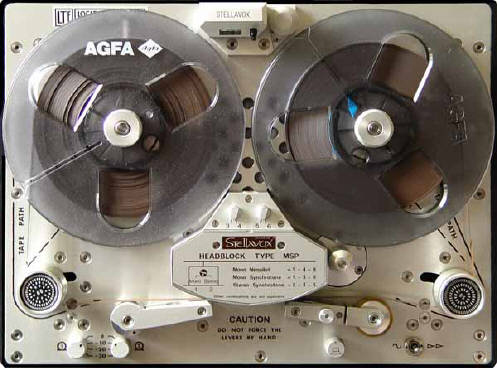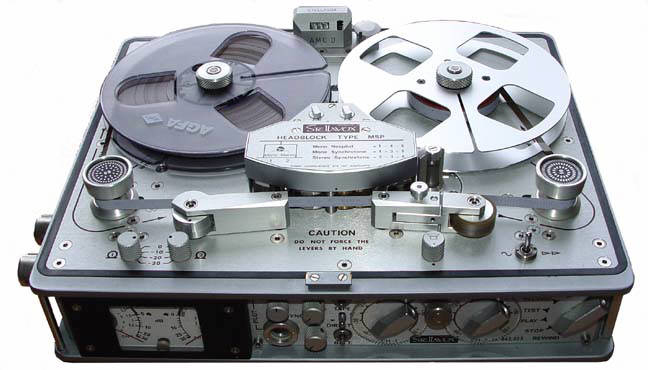Sourced from Gino Mancini May 2005
The Stellavox was the only true alternative to the Nagra portable audio recorder.
Also made in Switzerland and reputedly by some ex-Nagra employees, these machines were more compact, rather better finished and felt perhaps more developed than the Nagra. It was as if Nagra had left their own masterpiece slightly unfinished and that the Stellavox was something of anadvanced refinement. But things are never that simple and in addition to the interesting relationship that existed between these two companies, their products also show quite strongly differing personalities.
The father of the Stellavox, Mr Georges Quellet himself was kind enough to send me this image of his earlier SM5 recorder*.
It would seem that in 1950's in addition to those in America and Britain, a number of people in Switzerland were also developing high quality reel-to-reel magnetic tape recorders. Whereas Mr Studer would go on to produce his superb professional full size machines, Stephan Kudelski and Georges Quellet made far more 'pocketable' tape recorders. As a school boy I can also just remember the British Fi-cord brand of miniature audio recorders, though 30 years later I found out that these tiny exotic machines were also made in Switzerland (by Georges Quillet it would appear). It was though perhaps obvious that the combination of miniature electronics and precision mechanics needed to make a high quality tape recorder would suit a country also known for watchmaking, and one could argue that the end results would be some of the finest examples of 20th Century electro-mechanical engineering.
But the machine is very compact, and does have a fairly significant amount of conventional wiring inside. I once used to wire medical electronics for a living, and can only look at the Stellavox's internal 'spaghetti with some respect for those who knitted it all together (much better done though than the rat's nest to be found in much domestic electronics). And admittedly also with some concern if ever I had to do some serious fault finding in there... Yes the electronics is mostly modular plug in units, but what about the rest of it? Mind you the Nagra is also looks quite involved as well...
The recorder's specifications may be found here.
|


The above picture is Gino Mancini's own Stellavox SU8, and this was one of the last models from the original Stellavox company, this particular example dates from the mid 1980's. The 'U' stands for universal, because this version of the recorder came 'loaded' with a full range of modules and options as follows:
MSP module - switchable mono, stereo, 'snchrotone' and 'neopilot' head assembly
SXQ module - crystal pilot tone generator
SQS module - in-built synchronizer module and associated front panel controls
SOT option - balanced 600 Ohm input/output transformers and separate connections.
AMC tape counter unit
The recorder also has switchable 48V phantom or 'T' microphone powering together with a two position low frequency microphone filter, peak limiters and three position gain attenuators (these were fairly standard options I believe). The microphone gain controls have the optional 'ganged' gearing arrangement, and can be mixed with adjustable line inputs. Stellavox also made a recorder powered external microphone pre-amplifier (and various other external modules), so that one could have a fairly self-contained set of 4 microphone inputs if required. Oh, and the moulded plastic reel cover had the machined-satin-chromed 'thingy' fitted, for actuating the slate toggle while the machine is sitting in its leather case.
It would seem that in 1950's in addition to those in America and Britain a number of people in Switzerland were also developing high quality reel-to-reel magnetic tape recorders. Whereas Mr Studer would go on to produce his superb professional full size machines, Stephan Kudelski and Georges Quellet made far more 'pocketable' tape recorders. As a school boy I can also justremember the British Fi-cord brand of miniature audio recorders, though 30 years later I found out that these tiny exotic machines were also made in Switzerland (by Georges Quillet it wouldappear). It was though perhaps obvious that the combination of miniature electronics and precision mechanics needed to make a high quality tape recorder would suit a country also known for watchmaking, and one could argue that the end results would be some of the finest examples of 20th Century electromechanical engineering.
|

